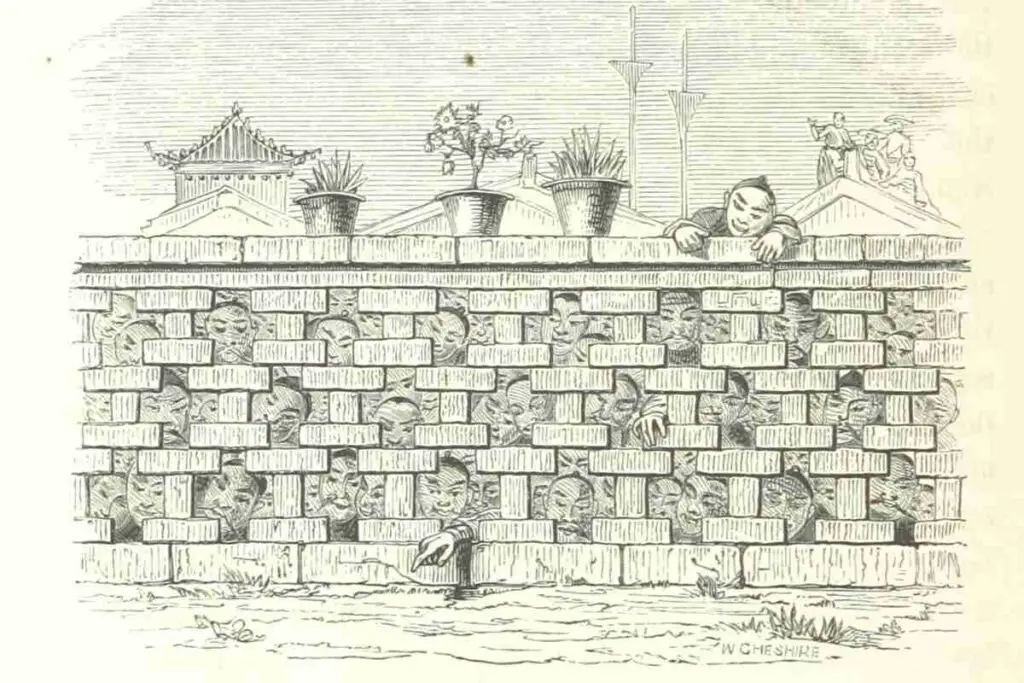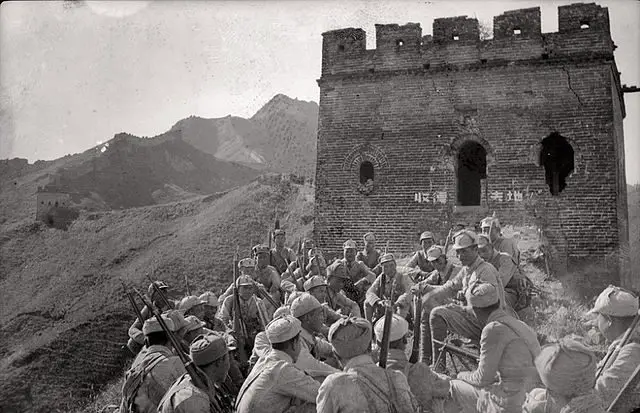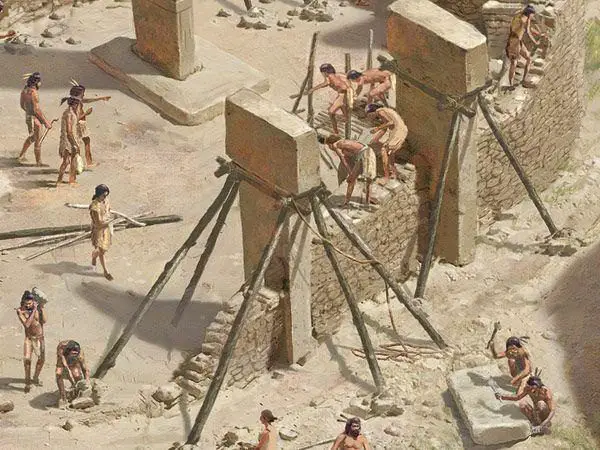When you visit the Great Wall of China, many visitors want to know if they are walking in what many consider a graveyard of dead bodies. Does the Great Wall of China have dead bodies inside the wall?
Bodies would not have been buried right into the wall, but they could have been buried in the earth near and even under the wall. They would not have put them right into the wall, as it would have caused structural damage when the bodies decomposed. The bodies are probably buried right by the wall, under some stone and other slabs.
Table of Contents
- The Great Wall of China – the Longest Cemetery On Earth
- Building The Great Wall Of China With Forced Labor
- Types Of Workers On The Great Wall
- 12 Reasons Why the Great Wall of China is an Emblematic Symbol of Chinese Culture and History
- Frequently Asked Questions
- Related Questions
The Great Wall of China – the Longest Cemetery On Earth

The Great Wall of China has been called by many the “Longest Cemetery On Earth.” No exact numbers of how many people died during the wall’s construction. Still, it has been estimated that probably anywhere from 400,000 to one million workers died during the wall construction.
We do not know how many people died as no one records the total number of people who worked and died building the wall. Some of these deaths could have been due to battles around the wall area and not the construction.
But contrary to the myth that the dead bodies are somehow buried in the wall itself, this has never been proven, as the decomposing bodies would have weakened the wall’s structure.
But many of these workers could be buried near or in sections of the wall that did not compromise the structure. Areas such as underparts of the wall or around the area of the wall. They could have been placed in sections where large rocks or other things were placed on the graves.
The construction work on the Great Wall was fierce and rudimentary. They had no machinery, and only elementary tools were used for all the heavy labor.
Most of the tools were basic, and much of the work was done by hand. Sometimes animals would be used, but the men did the heavy lifting and labor work most of the time.
Building The Great Wall Of China With Forced Labor

The Great Wall was a project of forced labor. Emperor Qin is known to have forced thousands of peasants, captured enemies, and criminals to work on the wall and to build the wall by hand. Many of these forced laborers were slave laborers who were not paid for their harsh and difficult work.
Here are some reasons why people may have died during the construction of the Great Wall of China:
- Attack By Warring State – The Great Wall was built to protect China from warring factions and states, especially in the north. The building of the Great Wall did not stop these attacks, so many peopled died in battle with these warring states or factions.
- Poor Working Conditions – Working on the wall would have been challenging and brutal. Many people would have died just from these poor working conditions.
- Not Enough Food – Workers were only given enough food to keep them alive, so many workers would have starved.
- Rocks Falling On Workers – The work on the Great Wall was dangerous, so many workers would have died from stones and other things falling on them.
- Exhaustion and Disease – Many of the workers died from exhaustion and disease.
No matter how the workers died, the Great Wall of China was a terrible place to work, and the workers worked in appalling conditions.

Listen To Our Podcast About The Great Wall of China – Is It The World’s Longest Cemetery? below or by clicking here.
Types Of Workers On The Great Wall
At the time of the Great Wall Construction, there were no machines, so the construction depended on all manual labor. The workers of the Great Wall worked on treacherous mountains and hills; it was not an easy job working on the Great Wall.
Since the Qin Dynasty (221 BC to 206 BC), the construction of the Great Wall has been a massive undertaking. Emperor Qin ordered millions of people to work on the Great Wall project.
According to historical data, the Great Wall labor comprised three groups: soldiers, ordinary people, and criminals.
Soldiers Who Worked On The Great Wall

Soldiers were one of the major groups who worked on the Great Wall. During the wall building in the Northern Qi (550 to 557), the soldiers were ordered to work on the Great Wall Construction.
Also, during the Qi Dynasty, at least 300,000 soldiers were part of the Great Wall construction crew. It took them nine years to finish the wall section they were working on.
As many of these soldiers came from other parts of China, the court ordered some widows to marry them to help them feel settled in their new area of construction.
Ordinary People Who Worked On the Great Wall

Millions of ordinary people were also ordered to work on the Great Wall. Many of these ordinary people were peasants. It is said that millions of peasant workers were required to help build the wall.
In a section of the Sui’s wall (581 to 618) in Inner Mongolia, at least one million men were required to help build the wall.
It was a significant burden on ordinary people to build the Great Wall. Many times almost all the men were forced to help make the wall. Even children were forced to join in the construction of the wall.
The forcing by the Chinese Dynasties of the peasants and laborers to help build the wall had enormous economic costs to the population. Men were working on the wall and not growing food in the fields.
Women also did not want to have a son or a male child because they feared their son would be forced to work on the wall construction. Many women lost their husbands while they were working on the Great Wall.
The construction of the Great Wall killed ordinary people and caused hardships to the peasants and their families, such as famine, poverty, and other issues. If you calculate the human cost of the Great Wall to not just the workers but also their families, the cost of lives is probably more than a couple million.
You can also watch our special video for this blog below,
Criminals Worked On The Great Wall

Criminals were also forced to work on the Great Wall. The labor was a punishment for them and their crimes. During the daytime, the criminals were ordered to take turns patrolling and guarding the wall.
At night they were to work and build to extend the wall. They did not get much sleep or much food. Many died of pure exhaustion and hunger.
According to the laws of the time, the criminals were required to serve at least four years of hard labor.
Many workers worked and died on the wall; dead bodies could be under, around, and even in the wall area. But it is not likely they were buried right in the wall structure itself, but around the area or in a part of the wall where the decomposing of the bodies would not hurt the overall structure of the wall.
12 Reasons Why the Great Wall of China is an Emblematic Symbol of Chinese Culture and History
The Great Wall of China, meandering through deserts, mountains, and plateaus, stands as an architectural marvel and a testament to China’s rich cultural tapestry.
Let’s delve into twelve reasons why this iconic structure holds unparalleled significance in Chinese culture and history:
- Historical Significance: Stretching over 13,000 miles, the Great Wall dates back to as early as the 7th century BC, with various dynasties contributing to its construction over centuries, making it a living chronicle of China’s past.
- Architectural Marvel: Representing ancient Chinese architectural prowess, the Wall incorporates watchtowers, fortresses, and intricate passageways, demonstrating sophisticated engineering techniques of different eras.
- Defensive Might: The primary purpose of the Wall was defense against invasions. Its very existence symbolizes the lengths to which Chinese dynasties went to protect their territories from northern invaders.
- Cultural Unity: While built for defense, the Wall also played a role in consolidating various regions under a single centralized rule, fostering a sense of cultural unity.
- Silk Road Protection: The Great Wall protected the lucrative Silk Road trade routes, ensuring the safe passage of goods, ideas, and cultures between the East and West.
- Symbol of Endurance: Despite being subjected to natural elements and human activities for millennia, significant parts of the Wall have endured, symbolizing resilience—a core value in Chinese culture.
- Socio-Economic Impact: Its construction mobilized millions of workers, including soldiers, peasants, and prisoners, over centuries. This massive workforce reflects the socio-economic dynamics of ancient China.
- Spiritual Significance: Many legends and folktales, like that of “Meng Jiangnu’s Tears,” which speaks of love, sacrifice, and resistance, are associated with the Wall, weaving it into the spiritual fabric of China.
- Astounding Geography: The Wall’s vast stretch across various terrains, from deserts to mountains, stands as a testament to China’s diverse and majestic geography.
- Cultural Events: Modern China uses the Wall as a backdrop for various cultural events, from marathons to music concerts, celebrating both ancient heritage and contemporary creativity.
- Tourism and Global Recognition: The Great Wall attracts millions of tourists annually as a UNESCO World Heritage site. It bridges, introducing global visitors to Chinese history and culture.
- National Identity: Beyond its historical and cultural importance, the Great Wall remains a symbol of national pride and identity, representing the collective spirit and tenacity of the Chinese people.
In essence, the Great Wall of China is more than just bricks and mortar. It encapsulates the spirit, history, and culture of China, standing tall as an enduring symbol of the nation’s past achievements and future aspirations.
At A Bus On A Dusty Road, we talk about everything about travel, life, sailing, and ex-pat living. We are all about “Living Life As A Global Citizen.” We explore social, cultural, and economic issues and travel.
We would love to have you be part of our community. Sign up for our newsletter to keep up-to-date by clicking here. If you have any questions, you can contact me, Anita, by clicking here.
Listen to our Podcast called Dusty Roads. You can find it on all major podcast platforms. Try out listening to one of our podcasts by clicking here.
Subscribe to our A Bus On A Dusty Road YouTube Channel filled with great videos and information by clicking here.
Frequently Asked Questions
How many dead bodies are in the Great Wall of China?
It is unclear how many dead bodies, if any, are in the Great Wall of China.
Are there bodies in the Great Wall of China?
While there is no evidence to suggest that bodies are buried within the structure of the Great Wall of China, there are reports of bodies being buried near or around the wall in some areas.
How many people died building the Great Wall of China?
It is difficult to estimate the exact number of people who died building the Great Wall of China, but it is believed to be in the thousands or even tens of thousands or more. We know that many died building the Great Wall of China.
Why was the Great Wall of China built?
The Great Wall of China was built as a defensive barrier to protect against invaders from the north
Can you walk on the Great Wall of China?
Yes, many sections of the Great Wall of China are open to tourists and visitors, and it is possible to walk along these sections
How long is the Great Wall of China?
The Great Wall of China is approximately 13,170 miles (21,196 km) long, although this measurement includes various sections that were built at different times.
How was the Great Wall of China constructed?
. The Great Wall of China was constructed using a variety of materials, including brick, tamped earth, and stone. It was built by hand, with workers carrying materials up and down steep slopes.
What is the condition of the Great Wall of China today?
Many sections of the Great Wall of China have been damaged or destroyed over time, but efforts are underway to preserve and restore the wall.
What is the future of the Great Wall of China?
The Great Wall of China will continue to be an important cultural and historical site, and efforts will continue to be made to preserve and protect this iconic symbol of Chinese history and culture
What are some of the challenges of preserving the Great Wall of China?
Some of the challenges of preserving the Great Wall of China include natural erosion, human activity, and inadequate funding for preservation efforts.
Related Questions
How Much Does The Great Wall Of China Weigh?
If you calculate the approximate number of bricks and the weight of each of those, the Great Wall of China would weigh over 50,000,000 tons. The Great Wall is considered the heaviest continuous structure on the face of the earth. As so many bricks were used to build the wall, if you put all the bricks side by side, it would go around the equator about 36 times.
By clicking here, you can discover How Much Does The Great Wall Of China Weigh?.
Where Does The Great Wall Of China End?
The Great Wall ends at what is known as the Jianyu Pass; this Jianyu Pass is the westernmost part of the Great Wall and also was known as the “First and Greatest Pass Under Heaven.” Some called it is the gates at the Jianyu Pass, the Gate of Travelers, and the Gate of Sighs.
You can learn more by reading Where Does The Great Wall Of China End? by clicking here.
How Long Did It Take to Build the Whole Great Wall of China?
The Great Wall of China took over 2,000 years to build. The building span over many Chinese Dynasties or for about 22 centuries. The construction of the wall ended in the Ming Dynasty in 1644. The Great Wall is one of the most significant human-made construction projects globally; the Great Wall is over 21,196 kilometers or 13,171 miles. There are over 25,000 watchtowers scattered throughout the Great Wall structure.
To know more about How Long Did It Take to Build the Whole Great Wall of China? by clicking here.

